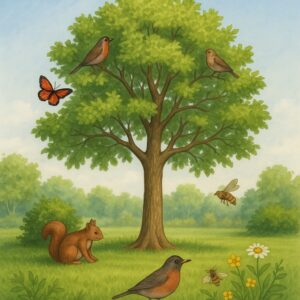 When you step outside and listen to birdsong, see a butterfly drifting by, or watch a squirrel scampering up a trunk, you’re witnessing just a small part of the complex web of life that trees sustain. Trees are much more than beautiful features in our yards and parks—they’re crucial pillars in every ecosystem, supporting a diverse array of wildlife and pollinators. Understanding how trees serve these vital roles not only increases our appreciation for them, but it also empowers us to make decisions that benefit the entire local environment.
When you step outside and listen to birdsong, see a butterfly drifting by, or watch a squirrel scampering up a trunk, you’re witnessing just a small part of the complex web of life that trees sustain. Trees are much more than beautiful features in our yards and parks—they’re crucial pillars in every ecosystem, supporting a diverse array of wildlife and pollinators. Understanding how trees serve these vital roles not only increases our appreciation for them, but it also empowers us to make decisions that benefit the entire local environment.
Trees: The Ultimate Wildlife Habitat
From their roots to their highest branches, trees offer food, shelter, and breeding grounds for countless species. Here are just some of the ways they contribute:
-
Nesting and Roosting: Birds rely on trees for nesting sites and cover from predators. Cavities in older trees provide homes for woodpeckers, owls, and small mammals like bats and squirrels. Even dead or decaying trees—known as “snags”—are valuable real estate for cavity-nesting birds and insects.
-
Food Source: Trees produce a buffet of food for wildlife. Leaves, flowers, fruit, seeds, and even bark provide nourishment for insects, birds, mammals, and more. For example, oaks support hundreds of caterpillar species, which in turn feed baby birds. Maple, cherry, and apple trees supply nectar for bees and fruit for birds and mammals.
-
Shelter from the Elements: The canopy shields creatures from rain, wind, and intense sun, while roots and leaf litter create moist, cool microhabitats for amphibians, reptiles, and soil organisms.
-
Migration Rest Stops: For migratory species, trees serve as critical waypoints—offering food and shelter during long journeys.
Trees and Pollinators: Partners in the Web of Life
Pollinators—bees, butterflies, moths, beetles, and even some birds and bats—are responsible for fertilizing many of the world’s flowering plants, including those that produce the fruits and nuts we eat. Trees play a major role in supporting these pollinators in several ways:
-
Nectar and Pollen: Flowering trees like willows, lindens, apples, cherries, and maples provide abundant nectar and pollen, especially during early spring when food sources are scarce. This early bloom is vital for pollinator survival.
-
Larval Host Plants: Many pollinators, especially butterflies and moths, lay their eggs on specific tree species. For instance, monarch caterpillars only feed on milkweed, but other butterflies use native trees like willows, oaks, and cherries as host plants.
-
Overwintering Sites: Trees offer sheltered nooks, bark, and leaf litter where pollinators can overwinter as eggs, larvae, pupae, or adults.
Trees and the Local Food Web
Every tree is a hub of interconnected relationships. Insects feed on leaves, birds eat the insects, mammals consume fruit and seeds, and fungi and microbes recycle fallen wood and leaves. Removing just one mature tree from the landscape can impact dozens of species, from the tiniest microbe to top predators like hawks and owls.
For example, a single mature oak can support more than 500 different species of caterpillars—which, in turn, are a major food source for baby birds during nesting season. Without these trees, local bird populations would plummet, affecting the entire ecosystem.
How Homeowners and Communities Can Help
-
Plant Native Trees: Native species support more wildlife and pollinators than non-native or ornamental trees. When choosing new trees, opt for those naturally found in your region.
-
Preserve Old Trees and Snags: Don’t rush to remove dead or aging trees if they don’t pose a safety risk. These “wildlife hotels” are vital habitats.
-
Avoid Pesticides: Pesticides can harm the insects and birds that trees support. Use integrated pest management or natural solutions when possible.
-
Create a Diverse Landscape: Plant a mix of trees, shrubs, and flowers to provide resources throughout the year.
Trees: A Gift That Keeps Giving
Every tree you plant, nurture, or preserve is an investment in your local wildlife and pollinator population. Trees don’t just stand tall for shade or beauty—they serve as lifelines for countless species that enrich our lives and keep ecosystems healthy.
Ready to make a difference?
Contact New Day Arborist for advice on tree selection, planting, and care that benefits you—and your wild neighbors. Let’s grow a greener, wilder, and more vibrant community together!